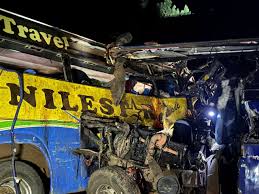On October 22, 2025, a devastating bus crash on the busy Kampala-Gulu Highway in Uganda claimed the lives of 63 people, marking one of the deadliest road accidents in the country’s recent history. This tragic event has not only shaken the local communities but also reignited critical conversations about road safety, driver behavior, and infrastructure challenges in Uganda. This blog post explores the details of the accident, its causes, the aftermath, and the urgent need for reforms to prevent such calamities in the future.
Details of the Tragic Accident on Kampala-Gulu Highway
The fatal collision occurred at around 12:15 am near Kitaleba Village, close to Asili Farm, along the Kampala-Gulu Highway. According to the Uganda Police Force, the crash involved four vehicles: two Isuzu buses, a Tata lorry, and a Toyota Surf saloon car. The buses were traveling in opposite directions - one going from Kampala towards Gulu and the other from Gulu towards Kampala.
Initial investigations revealed that both buses were simultaneously attempting to overtake slower vehicles. The bus heading north from Kampala tried to overtake the Tata lorry, while the southbound bus attempted to overtake the Toyota Surf. Tragically, the two buses collided head-on during these overtaking maneuvers, leading to a catastrophic chain reaction involving all four vehicles.
One of the drivers tried to swerve to avoid the collision, but the effort was unsuccessful. The impact caused several vehicles to overturn multiple times, resulting in a high number of casualties. All 63 lives lost were passengers in the involved vehicles. Several others sustained injuries and were rushed to Kiryandongo Hospital and other medical facilities nearby.
Human Toll and Community Impact
The death of 63 people in a single accident is a profound tragedy for Uganda, affecting families, friends, and entire communities connected to the victims. The hospital mortuary at Kiryandongo has been overwhelmed with bodies as officials conduct post-mortems and identification processes. The injuries sustained by the survivors are severe, and many remain hospitalized, requiring urgent medical attention.
This disaster has brought an outpouring of grief across the nation. Social media platforms are flooded with condolences and calls for action to improve road safety. Local leaders, politicians, and activists have expressed their sorrow and pledged support to the bereaved families.
Underlying Causes: Reckless Overtaking and Road Safety Challenges
Reckless overtaking is one of the leading causes of fatal road accidents in Uganda and many other countries. The complex geography of the Kampala-Gulu Highway, combined with the high volume of traffic and mixed vehicle types, makes it a hotspot for dangerous driving practices.
Several contributing factors to the crash can be identified:
Dangerous Overtaking: Both buses attempted to pass slower vehicles at the same time on a two-lane highway without sufficient visibility or safe passing zones.
Driver Behavior: The urge to save time may encourage risky maneuvers like overtaking in unsafe spots.
Road Infrastructure: Limited road safety features such as proper signage, overtaking lanes, and road-marking contribute to hazardous conditions.
Vehicle Condition: Heavy buses and lorries on poorly maintained roads increase the risk of accidents.

Government Response and Police Statement
The Uganda Police have responded quickly, dispatching officers to the scene and managing the aftermath. They have urged all motorists to exercise extreme caution, particularly avoiding dangerous overtaking maneuvers which remain a top cause of crashes. Traffic and road safety officials emphasized that such tragedies highlight the urgent need for ongoing awareness campaigns and strict enforcement of traffic laws.
Authorities are continuing investigations to establish accountability and further details. They offer heartfelt condolences to the families of the deceased and support for the injured.
Urgent Need for Road Safety Reforms
This tragic crash once again spotlights the critical need for comprehensive road safety reforms in Uganda. Some of the key areas requiring immediate attention include:
Enhanced Driver Training: Emphasizing defensive driving techniques and the dangers of reckless overtaking.
Improved Road Infrastructure: Constructing dual carriageways, adding overtaking lanes, clear signage, and better lighting can reduce collision risks.
Stricter Traffic Law Enforcement: Penalties and monitoring systems for speeding and dangerous driving need strengthening.
Public Awareness Campaigns: Educating the public on road safety rules through media, schools, and community programs.
Community and Individual Responsibility
While government and authorities play a vital role, every road user must take responsibility for safety. Drivers should exercise patience, avoid distractions, and respect traffic laws. Passengers can also support by promoting safe travel behaviors and reporting unsafe driving when possible.
Conclusion: A Call to Action
The horrific bus crash on the Kampala-Gulu Highway which claimed 63 lives is a tragedy that must serve as a wake-up call for Uganda and other countries facing similar issues. It highlights how reckless overtaking and road safety challenges can have devastating consequences.
As Uganda mourns these lost lives, it is also a moment to advocate for stronger road safety measures, better infrastructure, and responsible driving culture. Together, with concerted efforts from government, communities, and individuals, such incidents can be minimized, making Uganda’s roads safer for everyone.







Leave a Reply